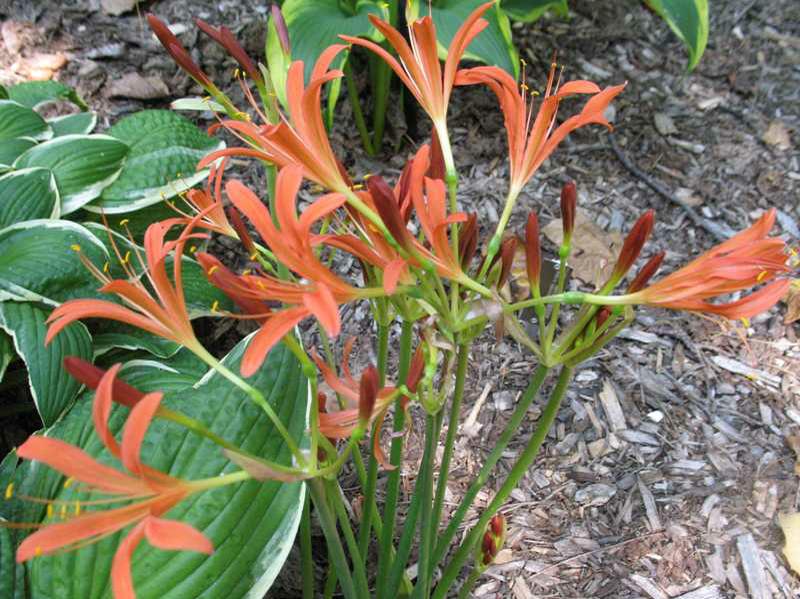Lycoris (Lycoris sanguinea)
Lycoris
Lycoris sanguinea is a bulbous perennial that is native to Japan and China. It is a member of the amaryllis family. Narrow-linear, strap-like, medium to dark green leaves (each to 2′ long) appear in spring, but disappear by early summer. Naked flower scapes emerge from the ground in mid-summer (usually the first of the lycoris to flower), each bearing an umbel of 4-6 orange-red flowers. Each flower (to 2” long) is funnel-shaped with six slightly reflexed, petal-like tepals and short stamens. Scapes typically rise to 1-2’ tall.
Genus name honors a Roman beauty, the mistress of Mark Antony.
Specific epithet comes from the Latin word meaning blood in reference to flower color, despite the color being more orange than red.
Plants in the genus Lycoris are sometimes commonly called resurrection flower, surprise lily or magic lily because the leaves disappear in summer with the naked flower scapes seemingly rising from the dead in late summer.

Winter hardy to USDA Zones 5b-10 where bulbs may be grown in organically rich, medium moisture, well-drained soils in full sun to part shade. Best flowering is in part shade. Plant bulbs 9” apart in fall with the top 1/4″ of the neck of each bulb exposed. Plants appreciate even moisture during their growing season, but may be best sited in areas where soils remain relatively dry during the summer dormant season. Plants will naturalize by bulb-offsets and form small colonies over time. Plants are best left undisturbed in the soil. Lycoris sanguinea has thrived outdoors in the ground at the Missouri Botanical Garden (USDA Zone 6b), and the culture recommendations set out herein follow the procedures currently in use at the Garden. North of USDA Zone 5, bulbs may be grown in large and deep containers that are overwintered indoors.
| Hardiness zone | 6 - 10 |
| Sun light | Full sun to part shade |
| Water | Medium |
| Maintenance | Medium |
No serious insect or disease problems. Lycoris may take a few seasons to establish in the St. Louis area.
Borders. Interplant with other perennials (including low-growing ground covers) and/or annuals.
| Common name | Lycoris |
| Botanical name | Lycoris sanguinea |
| Plant type | Bulb |
| Family | Amaryllidaceae |
| Hardiness zone | 6 - 10 |
| Water | Medium |
| Maintenance | Medium |
| Flower color | Orange-red |
| Flowering period | August - September |
| Height | 1 - 2 ft. |
| Width | 1 - 1.50 feet |